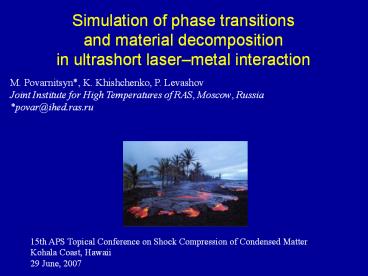Simulation of phase transitions and material decomposition in ultrashort laser - PowerPoint PPT Presentation
Title:
Simulation of phase transitions and material decomposition in ultrashort laser
Description:
Title: PRESSURE OF THE LATTICE Author: Mikhail Last modified by: misha Created Date: 6/19/2006 3:23:14 PM Document presentation format: Company – PowerPoint PPT presentation
Number of Views:127
Avg rating:3.0/5.0
Title: Simulation of phase transitions and material decomposition in ultrashort laser
1
Simulation of phase transitions and material
decompositionin ultrashort lasermetal
interaction
M. Povarnitsyn, K. Khishchenko, P.
Levashov Joint Institute for High Temperatures of
RAS, Moscow, Russia povar_at_ihed.ras.ru
15th APS Topical Conference on Shock Compression
of Condensed Matter Kohala Coast, Hawaii 29 June,
2007
2
Motivation Laser machining, micro- and
nanostructuring, laser-induced plasma
spectroscopy (LIPS), nanoparticle synthesis in
vacuum or in a liquid solution, medical imaging,
laser surgery, etc.
- Outline
- Problem setup main parameters
- Mechanisms of ultrashort laser ablation
- Numerical model
- Basic equations
- Equations of state (EOSs)
- Thermal decomposition model (homogeneous
nucleation) - Mechanical decomposition model (spallation)
- Results
- Dynamics of ablation
- Analysis of phase trajectories
- Ablation in the case of different EOSs
- Conclusions and future plans
3
Setup parameters
targets Al, Au, Cu, etc.
? 0.8 mkm, ?L 100 fs, ( FWHM ) F 0.1?5
J/cm2 Single pulse, Gaussian profile
laser
- Actual questions
- Heat wave propagation ?
- Melted zone depth ?
- Cavitation and fragmentation ?
- Parameters of the plume ?
- Generation of nanoparticles, clusters and
chunks ? - Ablation depth vs laser flux ?
4
Stages of ultrashort ablation
5
Basic equations
Two-temperature single-fluid multi-material
Eulerian hydrodynamics with sources of absorption
and energy exchange
6
Interface reconstruction algorithm
3D
2D
(b)
(a)
(d)
(c)
D. Youngs (1987) D. Littlefield (1999)
Symmetric difference approximation or some norm
minimization is used to determine unit normal
vector
(e)
Specific corner and specific orientation choice
makes only five possible intersections of the cell
7
Two-temperature semi-empirical EOS
Metastable EOS
Stable EOS
instant relaxation ? ? 0
frozen relaxation ? ? ?
8
Thermal decomposition of metastable liquid
Metastable liquid separation into liquid-gas
mixture
Terms used homogeneous nucleation phase
explosion explosive boiling critical point
phase separation
9
Model of homogeneous nucleation
0.9TcltTltTc
V. P. Skripov, Metastable Liquids (New York
Wiley, 1974). S. I. Tkachenko, V. S. Vorob'ev,
and S. P. Malyshenko, J. Phys. D Appl. Phys.
37, 495 (2004).
10
Mechanical spallation (cavitation)
liquid voids
Time to fracture is governed by the confluence of
voids
11
Spallation criteria
Minimal possible pressure
P lt -Y0
Energy minimization
D. Grady, J. Mech. Phys. Solids 36, 353 (1988).
12
Dynamics of ablation of Al target
F 5 J/cm2
?
?
P
P
?
M
T
?
P
P
13
Ablation dynamics of Al target
- 0.8 mkm
- ? 100 fs
- F 5 J/cm2
Al
14
Results with stable and metastable EOSs
(l)
15
Ablation depth in Al target
1. Povarnitsyn et al, PRB 75, 235414 (2007) 2.
Amoruso et al, Appl. Phys. 98, 044907 (2005)
3. Colombier et al, PRB 71, 165406 (2005) 4.
Komashko et al, Appl. Phys. A 69, S95 (1999)
5. Vidal et al, PRL 86, 2573 (2001)
16
Conclusions and Outlook
- Simulation results are sensitive to the models
used absorption, thermal conductivity,
electron-lattice collisions, kinetics of
nucleation, fragmentation criteria, EOS, etc - Time-dependent criteria of phase explosion and
cavitation in metastable liquid state were
introduced into hydrodynamic model - Observed decomposition of ablated substance is
due to - thermal phase separation in the vicinity of
critical point - mechanical fragmentation of liquid phase at high
strain rates and negative pressures - 4. Usage of metastable and stable equations of
state allows to take into account kinetics of
metastable phase separation in metastable liquid - Ablation depth correlates with the melted depth
- Treatment of individual droplets and bubbles will
be introduced since their size may be comparable
with the size of grid cells
17
Conclusions and Outlook
- Simulation results are sensitive to the models
used absorption, thermal conductivity,
electron-lattice collisions, kinetics of
nucleation, fragmentation criteria, EOS, etc - Time-dependent criteria of phase explosion and
cavitation in metastable liquid state were
introduced into hydrodynamic model - Observed decomposition of ablated substance is
due to - thermal phase separation in the vicinity of
critical point - mechanical fragmentation of liquid phase at high
strain rates and negative pressures - 4. Usage of metastable and stable equations of
state allows to take into account kinetics of
metastable phase separation in metastable liquid - Ablation depth correlates with the melted depth
- Treatment of individual droplets and bubbles will
be introduced since their size may be comparable
with the size of grid cells

